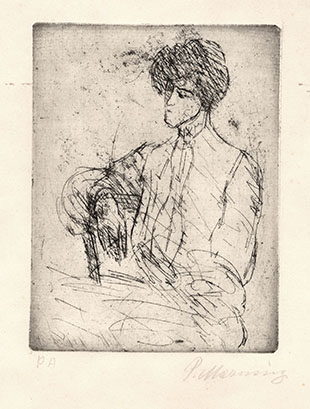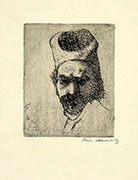(Trieste 1879 - Pavia 1837)
SEATED FEMALE FIGURE
Etching, printed on a large sheet of strong Japanese paper. Inscribed and signed in pencil PA / P Marussig.
To the platemark 115 x 87 mm., the full sheet 494 x 346.
The work of Piero Marussig as an etcher has been very little investigated. Nothing similar to a catalogue raisonné of his etchings exists, also if examples of his prints have been published in catalogues devoted to the artist.
in 2012 I personally did a survey of all the etchings by Marussig kept in Milan in the Bertarelli collection.
The Civic collection of prints Achille Bertarelli, in Milan, retains 29 different etchings by the artist, 8 of them in duplicate. Possibly the 29 prints are not the complete corpus of the artist's etchings, but certainly they are the biggest part of it. Most of the prints by Marussig in the Bertarelli collection are portraits (24), but there are also two landscapes, one ex libris, a small etching of a sleeping dog and a satirical etching depicting a miser in the face of Death.
Marussig worked with etching, drypoint and in a few cases used the roulette to give tone to his prints. It is interesting to note the provenance of the prints, which entered the collection through two purchases from the artist's widow. Through the first purchase (September 1938; no. 1583) the Bertarelli collection acquires from the widow and from the printer Fusetti 29 etchings. They all are printed on the same wove paper with black or sepia ink and certainly constitute and edition issued by the printer Fusetti, just after the death of Marussig. Through the second purchase (November 1945; no. 1847) 9 etchings are purchased from Marussig's widow. I have checked 8 of them, and they all are earlier impressions, often signed in pen or pencil by the artist.
The conclusions of my survey were that the impressions of Marussig etchings made by the artist himself are rare. On the other hand, posthumous impressions made by his wife are more common. These conclusions were confirmed by a subsequent survey of the 14 examples of Marussig etchings preserved in the Davoli collection in Reggio Emilia.
The son of a wealthy businessman and collector, Piero Marussig lived in Vienna and Monaco, between 1899 and 1901, where he approached the Viennese Secession and became familiar with the Central European expressionistic tendencies. He then lived in Rome for two years (1903-5) and spent a year in Paris (1905), where he studied Post-Impressionism and Fauvism. On his return to Italy in 1906 he lived in Trieste and, until about 1919, painted in a loosely expressionistic style. About 1920 he decided to move to Milan where he met Carra, Sironi and Funi. In Milan Marussig was among the founders of the group Novecento, along with painters Anselmo Bucci, Leonardo Dudreville, Achille Funi, Emilio Malerba, Mario Sironi and Ubaldo Oppi. His paintings of this period reflect the tendency of the group to a recovery of the Renaissance painting tradition.

